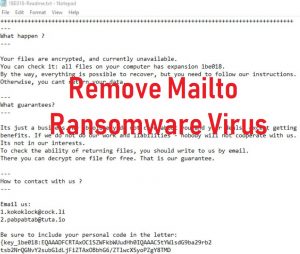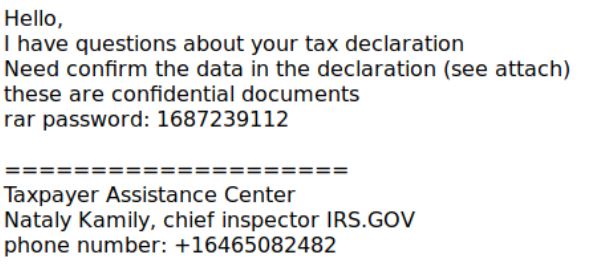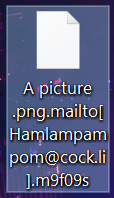 What is Mailto Virus? What are .mailto files? How to remove Mailto virus and try to restore .mailto files?
What is Mailto Virus? What are .mailto files? How to remove Mailto virus and try to restore .mailto files?
Mailto virus is the name of a nasty ransomware infection, whose main goal is to convince victims to pay ransom if they want to use their files once again. The virus enters your computer and encrypts your files by using an advanced encryption and then ads the .mailto[Hamlampampom@cock.li] file extension along with a custom idenfier, like .a8v28a, for example. The files cannot be opened and the virus ads a ransom note, with the unique extension and ending in -Readme.txt. Read this article to learn how to remove Mailto virus and try to restore files, encrypted by it.

Threat Summary
| Name | Mailto Virus |
| Type | Ransomware, Cryptovirus |
| Short Description | The Mailto virus aims to encrypt your files and then hold them hostage until you pay a hefty ransom to get them to work again. |
| Symptoms | The files have the .mailto file extension and the virus aims to leave behind the Readme.txt ransom note, containing the extortion message. |
| Distribution Method | Spam Emails, Email Attachments, Executable files |
| Detection Tool |
See If Your System Has Been Affected by malware
Download
Malware Removal Tool
|
User Experience | Join Our Forum to Discuss Mailto Virus. |
| Data Recovery Tool | Windows Data Recovery by Stellar Phoenix Notice! This product scans your drive sectors to recover lost files and it may not recover 100% of the encrypted files, but only few of them, depending on the situation and whether or not you have reformatted your drive. |
Tax Declaration Malspam Mailto Virus Ransomware Campaign
A new malicious SPAM campaign is currently targeting users worldwide by attaching the Mailto virus ransomware. The method of choice is the use of phishing email messages — large-scale networks and servers are being used to send out the fake messages. At the moment the active campaign delivers counterfeit IRS Declaration notifications. The hackers are spoofing the domain name of IRS and copying down the layout and design of the letters.
When the email messages are opened the victims will be manipulated into opening an attached file called IRSdeclarationexe.doc. These are macro-infected documents which also include a double extension file. In some cases it will also directly start the virus file. In the case of a macro-infected document a prompt will be spawned asking the victims to enable the built-in scripts. When this is done the virus infection will occur. One of the first actions it runs will be the removal of sensitive files including backups which makes it very hard to restore the computers. The main engine can also kill running processes and also to overtake administrative control over even system processes.
March 2020 Mailto Virus Ransomware Updates
The Mailto family of threats, which is also known as Netwalker has been found to contain an advanced code injection module — it makes use of a code injection into one of the most important Microsoft Windows processes called explorer.exe. This is one of the main programs used to power the Desktop environment and is necessary in order for Windows to function properly. Such actions have two main functions:
- Security Systems Evasion — By executing actions from the explorer.exe process many security software will not be triggere and the virus can continue by disabling them.
- System Control — The virus can overtake control of the operating system by using this process. This means that it can acquire administrative privileges from the this executable file.
The next action which is run from the main engine will include a information gathering module — it is used to hijack personal information that can be used for various identity and financial crimes, as well as the creation of a hardware report. This can be used to generate an unique ID to mark the hacked computer.
Other actions which are run by the Mailto Virus Ransomware include the setting up of the virus as a persistent infection — this means that the main engine will start when the computer is booted. It will also make the necessary changes in the Windows Registry — some of the consequences will include performance issues, the inability to access certain functions and also unexpected errors. To make recovery more difficult the Mailto virus ransomware will also delete system backups.

Mailto Virus – How Did I Get It and What Does It Do?
In order for you to get the Mailto virus, you must have opened a virus file. Such infection files are often spread as a result of being downloaded from sites, where they seem like they are legitimate type of programs, whereas in fact, they are far from that. Not only this, but to infect a computer, they also contain exploit kits that bypass traditional antivirus protection and then infect your computer without you even realizing it.
When your computer gets infected with the Mailto Virus, it could drop its virus files in the following Windows directories:
- %AppData%
- %Local%
- %Roaming%
- %Temp%
- %LocalLow%
When the modules are executed, the Mailto Virus may begin to encrypt the following files on your computer:
- Images.
- Videos.
- Documents.
- Audio files.
- Archives.
- Database files.
When the files are encrypted, blocks of data from them is replaced with data from the encryption algorithm used by the virus. Then the files are left looking like the following:
In addition to this, the Mailto Virus ads a ransom note with the following contents:
What happen ?
Your files are encrypted, and currently unavailable.
You can check it: all files on your computer has expansion 1be018.
By the way, everything is possible to recover, but you need to follow our instructions.
Otherwise, you cant return your data.
What guarantees?
Its just a business. We absolutely do not care about you and your deals, except getting
benefits. If we do not do our work and liabilities – nobody will not cooperate with us.
Its not in our interests.
To check the ability of returning files, you should write to us by email.
There you can decrypt one file for free. That is our guarantee.
How to contact with us ?
Email us:
1. hamlamampom@cock.li
2. galgalgalhalk@tuta.io
Be sure to include your personal code in the letter:
{key_1be018:EQAAADFCRTAx0C1SZWF kbWUudHh@IQAAAC5tYW1sdG9ba29rb2
tsb2NrQGNvY2subG1dLjFiZTAxOBbhG6/ZTlwcXSyoPZgY8TMD
Paying the ransom to the crooks behind the Mailto virus is highly inadvisable, since you should not trust them with your files. Furthermore, it is strongly recommended that you not pay absolutely anything to the same people whoe encrypted your files. Instead, we recommend saving the files for later decryption and removing the virus, using the steps underneath.

Remove Mailto Virus and Try to Restore .mailto Files
In order for you to remove the Mailto Virus by yourself, you can follow the removal instructions that are underneath. They have been created to help you delete Mailto Virus step by step from your computer. If you want a fast and automatic removal, however, then the most effective method is to download and run a scan with a specific anti-malware software. Such advanced tool is designed to detect and remove al virus files, related to the Mailto Virus from your computer and make sure that its protected in the future too.
Furthermore, if you want to try and get your files to work again, then we strongly recommend that you read the file recovery steps underneath. They have been created with the primary goal to help recover as many files, encrypted by the Mailto virus as possible, but bear in mind that they are not 100% guaranteed to work.
Steps to Prepare Before Removal:
Before starting to follow the steps below, be advised that you should first do the following preparations:
- Backup your files in case the worst happens.
- Make sure to have a device with these instructions on standy.
- Arm yourself with patience.
- 1. Scan for Mac Malware
- 2. Uninstall Risky Apps
- 3. Clean Your Browsers
Step 1: Scan for and remove Mailto Virus files from your Mac
When you are facing problems on your Mac as a result of unwanted scripts and programs such as Mailto Virus, the recommended way of eliminating the threat is by using an anti-malware program. SpyHunter for Mac offers advanced security features along with other modules that will improve your Mac’s security and protect it in the future.

Quick and Easy Mac Malware Video Removal Guide
Bonus Step: How to Make Your Mac Run Faster?
Mac machines maintain probably the fastest operating system out there. Still, Macs do become slow and sluggish sometimes. The video guide below examines all of the possible problems that may lead to your Mac being slower than usual as well as all of the steps that can help you to speed up your Mac.
Step 2: Uninstall Mailto Virus and remove related files and objects
1. Hit the ⇧+⌘+U keys to open Utilities. Another way is to click on “Go” and then click “Utilities”, like the image below shows:

2. Find Activity Monitor and double-click it:

3. In the Activity Monitor look for any suspicious processes, belonging or related to Mailto Virus:


4. Click on the "Go" button again, but this time select Applications. Another way is with the ⇧+⌘+A buttons.
5. In the Applications menu, look for any suspicious app or an app with a name, similar or identical to Mailto Virus. If you find it, right-click on the app and select “Move to Trash”.

6. Select Accounts, after which click on the Login Items preference. Your Mac will then show you a list of items that start automatically when you log in. Look for any suspicious apps identical or similar to Mailto Virus. Check the app you want to stop from running automatically and then select on the Minus (“-“) icon to hide it.
7. Remove any leftover files that might be related to this threat manually by following the sub-steps below:
- Go to Finder.
- In the search bar type the name of the app that you want to remove.
- Above the search bar change the two drop down menus to “System Files” and “Are Included” so that you can see all of the files associated with the application you want to remove. Bear in mind that some of the files may not be related to the app so be very careful which files you delete.
- If all of the files are related, hold the ⌘+A buttons to select them and then drive them to “Trash”.
In case you cannot remove Mailto Virus via Step 1 above:
In case you cannot find the virus files and objects in your Applications or other places we have shown above, you can manually look for them in the Libraries of your Mac. But before doing this, please read the disclaimer below:
1. Click on "Go" and Then "Go to Folder" as shown underneath:

2. Type in "/Library/LauchAgents/" and click Ok:

3. Delete all of the virus files that have similar or the same name as Mailto Virus. If you believe there is no such file, do not delete anything.

You can repeat the same procedure with the following other Library directories:
→ ~/Library/LaunchAgents
/Library/LaunchDaemons
Tip: ~ is there on purpose, because it leads to more LaunchAgents.
Step 3: Remove Mailto Virus – related extensions from Safari / Chrome / Firefox









Mailto Virus-FAQ
What is Mailto Virus on your Mac?
The Mailto Virus threat is probably a potentially unwanted app. There is also a chance it could be related to Mac malware. If so, such apps tend to slow your Mac down significantly and display advertisements. They could also use cookies and other trackers to obtain browsing information from the installed web browsers on your Mac.
Can Macs Get Viruses?
Yes. As much as any other device, Apple computers do get malware. Apple devices may not be a frequent target by malware authors, but rest assured that almost all of the Apple devices can become infected with a threat.
What Types of Mac Threats Are There?
According to most malware researchers and cyber-security experts, the types of threats that can currently infect your Mac can be rogue antivirus programs, adware or hijackers (PUPs), Trojan horses, ransomware and crypto-miner malware.
What To Do If I Have a Mac Virus, Like Mailto Virus?
Do not panic! You can easily get rid of most Mac threats by firstly isolating them and then removing them. One recommended way to do that is by using a reputable malware removal software that can take care of the removal automatically for you.
There are many Mac anti-malware apps out there that you can choose from. SpyHunter for Mac is one of the reccomended Mac anti-malware apps, that can scan for free and detect any viruses. This saves time for manual removal that you would otherwise have to do.
How to Secure My Data from Mailto Virus?
With few simple actions. First and foremost, it is imperative that you follow these steps:
Step 1: Find a safe computer and connect it to another network, not the one that your Mac was infected in.
Step 2: Change all of your passwords, starting from your e-mail passwords.
Step 3: Enable two-factor authentication for protection of your important accounts.
Step 4: Call your bank to change your credit card details (secret code, etc.) if you have saved your credit card for online shopping or have done online activiites with your card.
Step 5: Make sure to call your ISP (Internet provider or carrier) and ask them to change your IP address.
Step 6: Change your Wi-Fi password.
Step 7: (Optional): Make sure to scan all of the devices connected to your network for viruses and repeat these steps for them if they are affected.
Step 8: Install anti-malware software with real-time protection on every device you have.
Step 9: Try not to download software from sites you know nothing about and stay away from low-reputation websites in general.
If you follow these reccomendations, your network and Apple devices will become significantly more safe against any threats or information invasive software and be virus free and protected in the future too.
More tips you can find on our MacOS Virus section, where you can also ask any questions and comment about your Mac problems.
About the Mailto Virus Research
The content we publish on SensorsTechForum.com, this Mailto Virus how-to removal guide included, is the outcome of extensive research, hard work and our team’s devotion to help you remove the specific macOS issue.
How did we conduct the research on Mailto Virus?
Please note that our research is based on an independent investigation. We are in contact with independent security researchers, thanks to which we receive daily updates on the latest malware definitions, including the various types of Mac threats, especially adware and potentially unwanted apps (PUAs).
Furthermore, the research behind the Mailto Virus threat is backed with VirusTotal.
To better understand the threat posed by Mac malware, please refer to the following articles which provide knowledgeable details.




